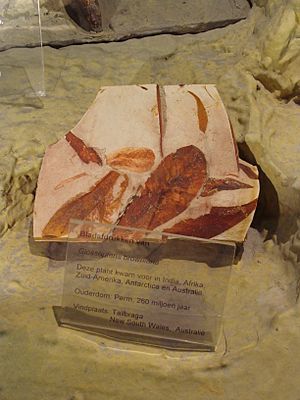Glossopteris facts for kids


Glossopteris was a very important type of extinct plant. It was the largest and most famous group of plants known as seed ferns. These plants were common in huge, wet forests called coal forests or coal swamps. These forests existed for a very long time, from about 323 million years ago (during the Pennsylvanian period) until about 252 million years ago (at the end of the Permian period).
These ancient coal swamps were found all over the world. This is because, during that long time, all the southern continents were joined together in one giant landmass called Gondwana. Because they were connected, these areas had similar warm, wet climates, perfect for Glossopteris to grow.
The Story of Glossopteris
The first Glossopteris plants appeared in the Southern Hemisphere around 300 million years ago, at the start of the Permian period. Scientists found fossils of these plants spread across many different continents that are now far apart. This wide distribution led a scientist named Eduard Suess to suggest that these southern continents must have once been connected as a single huge continent – what we now call Gondwana.
Glossopteris plants became the main type of plant in the southern parts of the world for the rest of the Permian period. However, they almost completely disappeared from everywhere at the end of the Permian, around 250 million years ago.
There are only a few possible records of Glossopteris from the very beginning of the Triassic period (the time after the Permian). These few fossils were found in Nidpur, India. Even these are a bit uncertain because the rocks there are mixed up from different time periods.
Some old textbooks might say that Glossopteris continued to live into later parts of the Triassic or even the Jurassic period. But these are usually mistakes. Scientists have found that these later fossils were actually other similar-looking plants, not true Glossopteris.
This means that Glossopteris was one of the biggest victims of the end-Permian mass extinction event. This was a time when a huge number of plants and animals on Earth died out.
Images for kids
See also
 In Spanish: Glossopteris para niños
In Spanish: Glossopteris para niños


